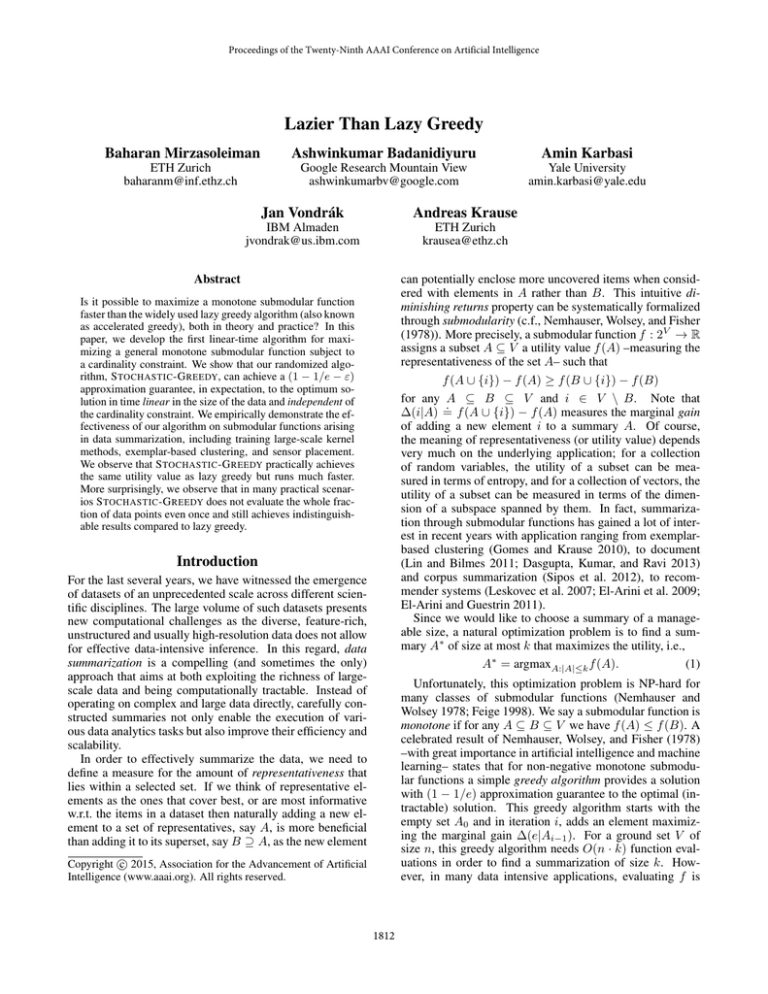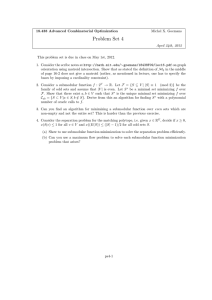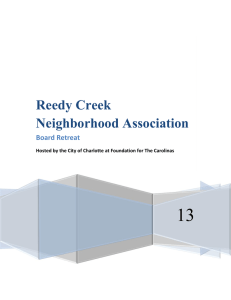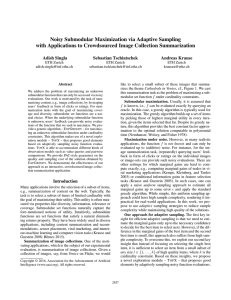
Proceedings of the Twenty-Ninth AAAI Conference on Artificial Intelligence
Lazier Than Lazy Greedy
Baharan Mirzasoleiman
Ashwinkumar Badanidiyuru
Amin Karbasi
ETH Zurich
baharanm@inf.ethz.ch
Google Research Mountain View
ashwinkumarbv@google.com
Yale University
amin.karbasi@yale.edu
Jan Vondrák
Andreas Krause
IBM Almaden
jvondrak@us.ibm.com
ETH Zurich
krausea@ethz.ch
Abstract
can potentially enclose more uncovered items when considered with elements in A rather than B. This intuitive diminishing returns property can be systematically formalized
through submodularity (c.f., Nemhauser, Wolsey, and Fisher
(1978)). More precisely, a submodular function f : 2V → R
assigns a subset A ⊆ V a utility value f (A) –measuring the
representativeness of the set A– such that
f (A ∪ {i}) − f (A) ≥ f (B ∪ {i}) − f (B)
for any A ⊆ B ⊆ V and i ∈ V \ B. Note that
.
∆(i|A) = f (A ∪ {i}) − f (A) measures the marginal gain
of adding a new element i to a summary A. Of course,
the meaning of representativeness (or utility value) depends
very much on the underlying application; for a collection
of random variables, the utility of a subset can be measured in terms of entropy, and for a collection of vectors, the
utility of a subset can be measured in terms of the dimension of a subspace spanned by them. In fact, summarization through submodular functions has gained a lot of interest in recent years with application ranging from exemplarbased clustering (Gomes and Krause 2010), to document
(Lin and Bilmes 2011; Dasgupta, Kumar, and Ravi 2013)
and corpus summarization (Sipos et al. 2012), to recommender systems (Leskovec et al. 2007; El-Arini et al. 2009;
El-Arini and Guestrin 2011).
Since we would like to choose a summary of a manageable size, a natural optimization problem is to find a summary A∗ of size at most k that maximizes the utility, i.e.,
A∗ = argmaxA:|A|≤k f (A).
(1)
Is it possible to maximize a monotone submodular function
faster than the widely used lazy greedy algorithm (also known
as accelerated greedy), both in theory and practice? In this
paper, we develop the first linear-time algorithm for maximizing a general monotone submodular function subject to
a cardinality constraint. We show that our randomized algorithm, S TOCHASTIC -G REEDY, can achieve a (1 − 1/e − ε)
approximation guarantee, in expectation, to the optimum solution in time linear in the size of the data and independent of
the cardinality constraint. We empirically demonstrate the effectiveness of our algorithm on submodular functions arising
in data summarization, including training large-scale kernel
methods, exemplar-based clustering, and sensor placement.
We observe that S TOCHASTIC -G REEDY practically achieves
the same utility value as lazy greedy but runs much faster.
More surprisingly, we observe that in many practical scenarios S TOCHASTIC -G REEDY does not evaluate the whole fraction of data points even once and still achieves indistinguishable results compared to lazy greedy.
Introduction
For the last several years, we have witnessed the emergence
of datasets of an unprecedented scale across different scientific disciplines. The large volume of such datasets presents
new computational challenges as the diverse, feature-rich,
unstructured and usually high-resolution data does not allow
for effective data-intensive inference. In this regard, data
summarization is a compelling (and sometimes the only)
approach that aims at both exploiting the richness of largescale data and being computationally tractable. Instead of
operating on complex and large data directly, carefully constructed summaries not only enable the execution of various data analytics tasks but also improve their efficiency and
scalability.
In order to effectively summarize the data, we need to
define a measure for the amount of representativeness that
lies within a selected set. If we think of representative elements as the ones that cover best, or are most informative
w.r.t. the items in a dataset then naturally adding a new element to a set of representatives, say A, is more beneficial
than adding it to its superset, say B ⊇ A, as the new element
Unfortunately, this optimization problem is NP-hard for
many classes of submodular functions (Nemhauser and
Wolsey 1978; Feige 1998). We say a submodular function is
monotone if for any A ⊆ B ⊆ V we have f (A) ≤ f (B). A
celebrated result of Nemhauser, Wolsey, and Fisher (1978)
–with great importance in artificial intelligence and machine
learning– states that for non-negative monotone submodular functions a simple greedy algorithm provides a solution
with (1 − 1/e) approximation guarantee to the optimal (intractable) solution. This greedy algorithm starts with the
empty set A0 and in iteration i, adds an element maximizing the marginal gain ∆(e|Ai−1 ). For a ground set V of
size n, this greedy algorithm needs O(n · k) function evaluations in order to find a summarization of size k. However, in many data intensive applications, evaluating f is
c 2015, Association for the Advancement of Artificial
Copyright Intelligence (www.aaai.org). All rights reserved.
1812
ants (Minoux 1978a; Leskovec et al. 2007) of the celebrated
greedy algorithm of Nemhauser, Wolsey, and Fisher (1978)
have been extensively used.
expensive and running the standard greedy algorithm is infeasible. Fortunately, submodularity can be exploited to implement an accelerated version of the classical greedy algorithm, usually called L AZY-G REEDY (Minoux 1978a). Instead of computing ∆(e|Ai−1 ) for each element e ∈ V , the
L AZY-G REEDY algorithm keeps an upper bound ρ(e) (initially ∞) on the marginal gain sorted in decreasing order. In
each iteration i, the L AZY-G REEDY algorithm evaluates the
element on top of the list, say e, and updates its upper bound,
ρ(e) ← ∆(e|Ai−1 ). If after the update ρ(e) ≥ ρ(e0 ) for all
e0 6= e, submodularity guarantees that e is the element with
the largest marginal gain. Even though the exact cost (i.e.,
number of function evaluations) of L AZY-G REEDY is unknown, this algorithm leads to orders of magnitude speedups
in practice. As a result, it has been used as the state-of-theart implementation in numerous applications including network monitoring (Leskovec et al. 2007), network inference
(Rodriguez, Leskovec, and Krause 2012), document summarization (Lin and Bilmes 2011), and speech data subset
selection (Wei et al. 2013), to name a few. However, as the
size of the data increases, even for small values of k, running L AZY-G REEDY is infeasible. A natural question to ask
is whether it is possible to further accelerate L AZY-G REEDY
by a procedure with a weaker dependency on k. Or even better, is it possible to have an algorithm that does not depend
on k at all and scales linearly with the data size n?
In this paper, we propose the first linear-time algorithm,
S TOCHASTIC -G REEDY, for maximizing a non-negative
monotone submodular function subject to a cardinality constraint k. We show that S TOCHASTIC -G REEDY achieves
a (1 − 1/e − ) approximation guarantee to the optimum solution with running time O(n log(1/)) (measured
in terms of function evaluations) that is independent of
k. Our experimental results on exemplar-based clustering
and active set selection in nonparametric learning also confirms that S TOCHASTIC -G REEDY consistently outperforms
L AZY-G REEDY by a large margin while achieving practically the same utility value. More surprisingly, in our experiments we observe that S TOCHASTIC -G REEDY sometimes
does not even evaluate all the items and shows a running
time that is less than n while still providing solutions close
to the ones returned by L AZY-G REEDY. Due to its independence of k, S TOCHASTIC -G REEDY is the first algorithm
that truly scales to voluminous datasets.
Scaling Up: To solve the optimization problem (1) at
scale, there have been very recent efforts to either make
use of parallel computing methods or treat data in a
streaming fashion. In particular, Chierichetti, Kumar, and
Tomkins (2010) and Blelloch, Peng, and Tangwongsan
(2011) addressed a particular instance of submodular
functions, namely, maximum coverage and provided a
distributed method with a constant factor approximation
to the centralized algorithm. More generally, Kumar et al.
(2013) provided a constant approximation guarantee for
general submodular functions with bounded marginal gains.
Contemporarily, Mirzasoleiman et al. (2013) developed a
two-stage distributed algorithm that guarantees solutions
close to the optimum if the dataset is massive and the
submodular function is smooth.
Similarly, Gomes and Krause (2010) presented a heuristic
streaming algorithm for submodular function maximization
and showed that under strong assumptions about the way
the data stream is generated their method is effective. Very
recently, Badanidiyuru et al. (2014) provided the first onepass streaming algorithm with a constant factor approximation guarantee for general submodular functions without any
assumption about the data stream.
Even though the goal of this paper is quite different
and complementary in nature to the aforementioned work,
S TOCHASTIC -G REEDY can be easily integrated into existing distributed methods. For instance, S TOCHASTIC G REEDY can replace L AZY-G REEDY for solving each subproblem in the approach of Mirzasoleiman et al. (2013).
More generally, any distributed algorithm that uses L AZYG REEDY as a sub-routine, can directly benefit from our
method and provide even more efficient large-scale algorithmic frameworks.
Our Approach: In this paper, we develop the first centralized algorithm whose cost (i.e., number of function evaluations) is independent of the cardinality constraint, which in
turn directly addresses the shortcoming of L AZY-G REEDY.
Perhaps the closest, in spirit, to our efforts are approaches
by Wei, Iyer, and Bilmes (2014) and Badanidiyuru and
Vondrák (2014). Concretely, Wei, Iyer, and Bilmes (2014)
proposed a multistage algorithm, M ULTI -G REEDY, that
tries to decrease the running time of L AZY-G REEDY by
approximating the underlying submodular function with a
set of (sub)modular functions that can be potentially evaluated less expensively. This approach is effective only
for those submodular functions that can be easily decomposed and approximated. Note again that S TOCHASTIC G REEDY can be used for solving the sub-problems in each
stage of M ULTI -G REEDY to develop a faster multistage
method. Badanidiyuru and Vondrák (2014) proposed a different centralized algorithm that achieves a (1 − 1/e −
) approximation guarantee for general submodular functions using O(n/ log(n/)) function evaluations. However,
Related Work
Submodularity is a property of set functions with deep theoretical and practical consequences. For instance, submodular maximization generalizes many well-known combinatorial problems including maximum weighted matching, max coverage, and facility location, to name a few. It
has also found numerous applications in machine learning
and artificial intelligence such as influence maximization
(Kempe, Kleinberg, and Tardos 2003), information gathering (Krause and Guestrin 2011), document summarization (Lin and Bilmes 2011) and active learning (Guillory
and Bilmes 2011; Golovin and Krause 2011). In most of
these applications one needs to handle increasingly larger
quantities of data. For this purpose, accelerated/lazy vari-
1813
S TOCHASTIC -G REEDY consistently outperforms their algorithm in practice in terms of cost, and returns higher utility value. In addition, S TOCHASTIC -G REEDY uses only
O(n log(1/)) function evaluations in theory, and thus provides a stronger analytical guarantee.
general monotone submodular functions, with computational complexity independent of the cardinality constraint.
Theorem 1. Let f be a non-negative monotone submoduar
function. Let us also set s = nk log 1 . Then S TOCHASTIC G REEDY achieves a (1 − 1/e − ) approximation guarantee
in expectation to the optimum solution of problem (1) with
only O(n log 1 ) function evaluations.
Since there are k iterations in total and at each iteration we have (n/k) log(1/) elements, the total
number of function evaluations cannot be more than
k × (n/k) log(1/) = n log(1/). The proof of the
approximation guarantee is given in the analysis section.
S TOCHASTIC -G REEDY Algorithm
In this section, we present our randomized greedy algorithm
S TOCHASTIC -G REEDY and then show how to combine it
with lazy evaluations. We will show that S TOCHASTIC G REEDY has provably linear running time independent of
k, while simultaneously having the same approximation ratio guarantee (in expectation). In the following section we
will further demonstrate through experiments that this is also
reflected in practice, i.e., S TOCHASTIC -G REEDY is substantially faster than L AZY-G REEDY, while being practically
identical to it in terms of the utility.
The main idea behind S TOCHASTIC -G REEDY is to produce an element which improves the value of the solution
roughly the same as greedy, but in a fast manner. This is
achieved by a sub-sampling step. At a very high level this
is similar to how stochastic gradient descent improves the
running time of gradient descent for convex optimization.
Random Sampling with Lazy Evaluation
While our theoretical results show a provably linear time algorithm, we can combine the random sampling procedure
with lazy evaluation to boost its performance. There are
mainly two reasons why lazy evaluation helps. First, the
randomly sampled sets can overlap and we can exploit the
previously evaluated marginal gains. Second, as in L AZYG REEDY although the marginal values of the elements might
change in each step of the greedy algorithm, often their ordering does not change (Minoux 1978a). Hence in line 4
of Algorithm 1 we can apply directly lazy evaluation as follows. We maintain an upper bound ρ(e) (initially ∞) on
the marginal gain of all elements sorted in decreasing order.
In each iteration i, S TOCHASTIC -G REEDY samples a set R.
From this set R it evaluates the element that comes on top
of the list. Let’s denote this element by e. It then updates
the upper bound for e, i.e., ρ(e) ← ∆(e|Ai−1 ). If after the
update ρ(e) ≥ ρ(e0 ) for all e0 6= e where e, e0 ∈ R, submodularity guarantees that e is the element with the largest
marginal gain in the set R. Hence, lazy evaluation helps us
reduce function evaluation in each round.
Random Sampling
The key reason that the classic greedy algorithm works is
that at each iteration i, an element is identified that reduces
the gap to the optimal solution by a significant amount, i.e.,
by at least (f (A∗ ) − f (Ai−1 ))/k. This requires n oracle
calls per step, the main bottleneck of the classic greedy algorithm. Our main observation here is that by submodularity, we can achieve the same improvement by adding a
uniformly random element from A∗ to our current set A. To
get this improvement, we will see that it is enough to randomly sample a set R of size (n/k) log(1/), which in turn
overlaps with A∗ with probability 1 − . This is the main
reason we are able to achieve a boost in performance.
The algorithm is formally presented in Algorithm 1. Similar to the greedy algorithm, our algorithm starts with an
empty set and adds one element at each iteration. But in
each step it first samples a set R of size (n/k) log(1/) uniformly at random and then adds the element from R to A
which increases its value the most.
Experimental Results
In this section, we address the following questions: 1)
how well does S TOCHASTIC -G REEDY perform compared
to previous art and in particular L AZY-G REEDY, and 2)
How does S TOCHASTIC -G REEDY help us get near optimal
solutions on large datasets by reducing the computational
complexity? To this end, we compare the performance of
our S TOCHASTIC -G REEDY method to the following benchmarks: R ANDOM -S ELECTION, where the output is k randomly selected data points from V ; L AZY-G REEDY, where
the output is the k data points produced by the accelerated
greedy method (Minoux 1978a); S AMPLE -G REEDY, where
the output is the k data points produced by applying L AZYG REEDY on a subset of data points parametrized by sampling probability p; and T HRESHOLD -G REEDY, where the
output is the k data points provided by the algorithm of
Badanidiyuru et al. (2014). In order to compare the computational cost of different methods independently of the
concrete implementation and platform, in our experiments
we measure the computational cost in terms of the number
of function evaluations used. Moreover, to implement the
S AMPLE -G REEDY method, random subsamples are generated geometrically using different values for probability p.
Algorithm 1 S TOCHASTIC -G REEDY
Input: f : 2V → R+ , k ∈ {1, . . . , n}.
Output: A set A ⊆ V satisfying |A| ≤ k.
1: A ← ∅.
2: for (i ← 1; i ≤ k; i ← i + 1) do
3:
R ← a random subset obtained by sampling s random
elements from V \ A.
4:
ai ← argmaxa∈R ∆(a|A).
5:
A ← A ∪ {ai }
6: return A.
Our main theoretical result is the following. It shows that
S TOCHASTIC -G REEDY achieves a near-optimal solution for
1814
Higher values of p result in subsamples of larger size from
the original dataset. To maximize fairness, we implemented
an accelerated version of T HRESHOLD -G REEDY with lazy
evaluations (not specified in the paper) and report the best
results in terms of function evaluations. Among all benchmarks, R ANDOM -S ELECTION has the lowest computational
cost (namely, one) as we need to only evaluate the selected
set at the end of the sampling process. However, it provides
the lowest utility. On the other side of the spectrum, L AZYG REEDY makes k passes over the full ground set, providing
typically the best solution in terms of utility. The lazy evaluation eliminates a large fraction of the function evaluations
in each pass. Nonetheless, it is still computationally prohibitive for large values of k.
In our experimental setup, we focus on three important
and classic machine learning applications: nonparametric
learning, exemplar-based clustering, and sensor placement.
vectors to zero mean and unit norm. Fig. 1a and 1b compare the utility and computational cost of S TOCHASTIC G REEDY to the benchmarks for different values of k. For
T HRESHOLD -G REEDY, different values of have been chosen such that a performance close to that of L AZY-G REEDY
is obtained. Moreover, different values of p have been chosen such that the cost of S AMPLE -G REEDY is almost equal
to that of S TOCHASTIC -G REEDY for different values of .
As we can see, S TOCHASTIC -G REEDY provides the closest
(practically identical) utility to that of L AZY-G REEDY with
much lower computational cost. Decreasing the value of ε
results in higher utility at the price of higher computational
cost. Fig. 1c shows the utility versus cost of S TOCHASTIC G REEDY along with the other benchmarks for a fixed k =
200 and different values of . S TOCHASTIC -G REEDY provides very compelling tradeoffs between utility and cost
compared to all benchmarks, including L AZY-G REEDY.
Nonparametric Learning. Our first application is data
subset selection in nonparametric learning. We focus on the
special case of Gaussian Processes (GPs) below, but similar problems arise in large-scale kernelized SVMs and other
kernel machines. Let XV , be a set of random variables indexed by the ground set V . In a Gaussian Process (GP)
we assume that every subset XS , for S = {e1 , . . . , es },
is distributed according to a multivariate normal distribution, i.e., P (XS = xS ) = N (xS ; µS , ΣS,S ), where µS =
(µe1 , . . . , µes ) and ΣS,S = [Kei ,ej ](1 ≤ i, j ≤ k) are
the prior mean vector and prior covariance matrix, respectively. The covariance matrix is given in terms of a positive definite kernel K, e.g., the squared exponential kernel
Kei ,ej = exp(−|ei − ej |22 /h2 ) is a common choice in practice. In GP regression, each data point e ∈ V is considered a
random variable. Upon observations yA = xA + nA (where
nA is a vector of independent Gaussian noise with variance
σ 2 ), the predictive distribution of a new data point e ∈ V is
a normal distribution P (Xe | yA ) = N (µe|A , Σ2e|A ), where
Exemplar-based clustering. A classic way to select a set
of exemplars that best represent a massive dataset is to solve
the k-medoid problem (Kaufman and Rousseeuw 2009) by
minimizing the sum of pairwise dissimilarities between exemplars
P A and elements of the dataset V as follows: L(A) =
1
e∈V minv∈A d(e, v), where d : V × V → R is a disV
tance function, encoding the dissimilarity between elements.
By introducing an appropriate auxiliary element e0 we can
turn L into a monotone submodular function (Gomes and
Krause 2010): f (A) = L({e0 }) − L(A ∪ {e0 }). Thus maximizing f is equivalent to minimizing L which provides a
very good solution. But the problem becomes computationally challenging as the size of the summary A increases.
In our experiment we chose d(x, x0 ) = ||x − x0 ||2 for the
dissimilarity measure. We used a set of 10,000 Tiny Images
(Torralba, Fergus, and Freeman 2008) where each 32 × 32
RGB image was represented by a 3,072 dimensional vector.
We subtracted from each vector the mean value, normalized
it to unit norm, and used the origin as the auxiliary exemplar. Fig. 1d and 1e compare the utility and computational
cost of S TOCHASTIC -G REEDY to the benchmarks for different values of k. It can be seen that S TOCHASTIC -G REEDY
outperforms the benchmarks with significantly lower computational cost. Fig. 1f compares the utility versus cost of
different methods for a fixed k = 200 and various p and .
Similar to the previous experiment, S TOCHASTIC -G REEDY
achieves near-maximal utility at substantially lower cost
compared to the other benchmarks.
Large scale experiment. We also performed a similar experiment on a larger set of 50,000 Tiny Images. For
this dataset, we were not able to run L AZY-G REEDY and
T HRESHOLD -G REEDY. Hence, we compared the utility and
cost of S TOCHASTIC -G REEDY with R ANDOM -S ELECTION
using different values of p. As shown in Fig. 1j and Fig. 1k,
S TOCHASTIC -G REEDY outperforms S AMPLE -G REEDY in
terms of both utility and cost for different values of k. Finally, as Fig. 1l shows that S TOCHASTIC -G REEDY achieves
the highest utility but performs much faster compare to
S AMPLE -G REEDY which is the only practical solution for
this larger dataset.
µe|A = µe + Σe,A (ΣA,A + σ 2 I)−1 (xA − µA ),
2
σe|A
= σe2 − Σe,A (ΣA,A + σ 2 I)−1 ΣA,e .
(2)
Note that evaluating (2) is computationally expensive as
it requires a matrix inversion. Instead, most efficient approaches for making predictions in GPs rely on choosing a
small – so called active – set of data points. For instance, in
the Informative Vector Machine (IVM) we seek a summary
A such that the information gain, f (A) = I(YA ; XV ) =
H(XV ) − H(XV |YA ) = 12 log det(I + σ −2 ΣA,A ) is maximized. It can be shown that this choice of f is monotone
submodular (Krause and Guestrin 2005). For small values
of |A|, running L AZY-G REEDY is possible. However, we
see that as the size of the active set or summary A increases,
the only viable option in practice is S TOCHASTIC -G REEDY.
In our experiment we chose a Gaussian kernel with h =
0.75 and σ = 1. We used the Parkinsons Telemonitoring dataset (Tsanas et al. 2010) consisting of 5,875 biomedical voice measurements with 22 attributes from people with early-stage Parkinsons disease. We normalized the
1815
Lemma 2. Given a current solution A, the expected
gainPof S TOCHASTIC -G REEDY in one step is at least
1−
a∈A∗ \A ∆(a|A).
k
Sensor Placement. When monitoring spatial phenomena,
we want to deploy a limited number of sensors in an area
in order to quickly detect contaminants. Thus, the problem
would be to select a subset of all possible locations A ⊆ V to
place sensors. Consider a set of intrusion scenarios I where
each scenario i ∈ I defines the introduction of a contaminant at a specified point in time. For each sensor s ∈ S
and scenario i, the detection time, T (s, i), is defined as the
time it takes for s to detect i. If s never detects i, we set
T (s, i) = ∞. For a set of sensors A, detection time for
scenario i could be defined as T (A, i) = mins∈A T (s, i).
Depending on the time of detection, we incur penalty πi (t)
for detecting scenario i at time t. Let πi (∞) be the maximum penalty incurred if the scenario i is not detected at
all. Then, the penalty reduction for scenario i can be defined as R(A, i) = πi (∞) − πi (T (A, i)). Having a probability distribution over possible scenarios, we can calculate
the expected
P penalty reduction for a sensor placement A as
R(A) = i∈I P (i)R(A, i). This function is montone submodular (Krause et al. 2008) and for which the greedy algorithm gives us a good solution. For massive data however,
we may need to resort to S TOCHASTIC -G REEDY.
In our experiments we used the 12,527 node distribution network provided as part of the Battle of Water Sensor Networks (BWSN) challenge (Ostfeld et al. 2008). Fig.
1g and 1h compare the utility and computational cost of
S TOCHASTIC -G REEDY to the benchmarks for different values of k. It can be seen that S TOCHASTIC -G REEDY outperforms the benchmarks with significantly lower computational cost. Fig. 1i compares the utility versus cost of different methods for a fixed k = 200 and various p and . Again
S TOCHASTIC -G REEDY shows similar behavior to the previous experiments by achieving near-maximal utility at much
lower cost compared to the other benchmarks.
Proof. Let us estimate the probability that R∩(A∗ \A) 6= ∅.
The set R consists of s = nk log 1 random samples from
V \ A (w.l.o.g. with repetition), and hence
s
|A∗ \ A|
Pr[R ∩ (A∗ \ A) = ∅] = 1 −
|V \ A|
|A∗ \A|
−s |V \A|
≤e s ∗
≤ e− n |A \A| .
s
Therefore, by using the concavity of 1 − e− n x as a function
of x and the fact that x = |A∗ \ A| ∈ [0, k], we have
∗
∗
s
sk |A \ A|
Pr[R∩(A∗ \A) 6= ∅] ≥ 1−e− n |A \A| ≥ (1−e− n )
.
k
n
1
Recall that we chose s = k log , which gives
|A∗ \ A|
.
(3)
Pr[R ∩ (A∗ \ A) 6= ∅] ≥ (1 − )
k
Now consider S TOCHASTIC -G REEDY: it picks an element
a ∈ R maximizing the marginal value ∆(a|A). This is
clearly as much as the marginal value of an element randomly chosen from R ∩ (A∗ \ A) (if nonempty). Overall,
R is equally likely to contain each element of A∗ \ A, so
a uniformly random element of R ∩ (A∗ \ A) is actually a
uniformly random element of A∗ \ A. Thus, we obtain
X
1
∆(a|A).
E[∆(a|A)] ≥ Pr[R∩(A∗ \A) 6= ∅]× ∗
|A \ A|
∗
a∈A \A
Using
P (3),
1−
k
we conclude
∆(a|A).
∗
a∈A \A
that
E[∆(a|A)]
≥
Now it is straightforward to finish the proof of Theorem 1. Let Ai = {a1 , . . . , ai } denote the solution returned
by S TOCHASTIC -G REEDY after i steps. From Lemma 2,
1− X
E[∆(ai+1 |Ai ) | Ai ] ≥
∆(a|Ai ).
k
a∈A∗ \Ai
By submodularity,
X
∆(a|Ai ) ≥ ∆(A∗ |Ai ) ≥ f (A∗ ) − f (Ai ).
Conclusion
We have developed the first linear time algorithm
S TOCHASTIC -G REEDY with no dependence on k
for cardinality constrained submodular maximization.
S TOCHASTIC -G REEDY provides a 1 − 1/e − approximation guarantee to the optimum solution with only
n log 1 function evaluations. We have also demonstrated
the effectiveness of our algorithm through an extensive set
of experiments. As these show, S TOCHASTIC -G REEDY
achieves a major fraction of the function utility with much
less computational cost. This improvement is useful even
in approaches that make use of parallel computing or decompose the submodular function into simpler functions for
faster evaluation. The properties of S TOCHASTIC -G REEDY
make it very appealing and necessary for solving very
large scale problems. Given the importance of submodular
optimization to numerous AI and machine learning applications, we believe our results provide an important step
towards addressing such problems at scale.
a∈A∗ \Ai
Therefore,
E[f (Ai+1 ) − f (Ai ) | Ai ] = E[∆(ai+1 |Ai ) | Ai ]
1−
≥
(f (A∗ ) − f (Ai )).
k
By taking expectation over Ai ,
1−
E[f (Ai+1 ) − f (Ai )] ≥
E[f (A∗ ) − f (Ai )].
k
By induction, this implies that
k !
1−
E[f (Ak )] ≥ 1 − 1 −
f (A∗ )
k
≥ 1 − e−(1−) f (A∗ ) ≥ (1 − 1/e − )f (A∗ ).
Appendix, Analysis
Acknowledgment. This research was supported by SNF
200021-137971, ERC StG 307036, a Microsoft Faculty Fellowship, and an ETH Fellowship.
The following lemma gives us the approximation guarantee.
1816
Figure 1: Performance comparisons. a), d) g) and j) show the performance of all the algorithms for different values of k on
Parkinsons Telemonitoring, a set of 10,000 Tiny Images, Water Network, and a set of 50,000 Tiny Images respectively. b), e) h)
and k) show the cost of all the algorithms for different values of k on the same datasets. c), f), i), l) show the utility obtained
versus cost for a fixed k = 200.
1817
References
Minoux, M. 1978a. Accelerated greedy algorithms for maximizing submodular set functions. Optimization Techniques,
LNCS 234–243.
Minoux, M. 1978b. Accelerated greedy algorithms for maximizing submodular set functions. In Proc. of the 8th IFIP
Conference on Optimization Techniques. Springer.
Mirzasoleiman, B.; Karbasi, A.; Sarkar, R.; and Krause, A.
2013. Distributed submodular maximization: Identifying
representative elements in massive data. In Neural Information Processing Systems (NIPS).
Nemhauser, G. L., and Wolsey, L. A. 1978. Best algorithms
for approximating the maximum of a submodular set function. Math. Oper. Research.
Nemhauser, G. L.; Wolsey, L. A.; and Fisher, M. L. 1978.
An analysis of approximations for maximizing submodular
set functions - I. Mathematical Programming.
Ostfeld, A.; Uber, J. G.; Salomons, E.; Berry, J. W.; Hart,
W. E.; Phillips, C. A.; Watson, J.-P.; Dorini, G.; Jonkergouw, P.; Kapelan, Z.; et al. 2008. The battle of the water
sensor networks (bwsn): A design challenge for engineers
and algorithms. Journal of Water Resources Planning and
Management 134(6):556–568.
Rodriguez, M. G.; Leskovec, J.; and Krause, A. 2012. Inferring networks of diffusion and influence. ACM Transactions
on Knowledge Discovery from Data 5(4):21:1–21:37.
Sipos, R.; Swaminathan, A.; Shivaswamy, P.; and Joachims,
T. 2012. Temporal corpus summarization using submodular
word coverage. In CIKM.
Torralba, A.; Fergus, R.; and Freeman, W. T. 2008. 80 million tiny images: A large data set for nonparametric object
and scene recognition. IEEE Trans. Pattern Anal. Mach. Intell.
Tsanas, A.; Little, M. A.; McSharry, P. E.; and Ramig, L. O.
2010. Enhanced classical dysphonia measures and sparse regression for telemonitoring of parkinson’s disease progression. In IEEE Int. Conf. Acoust. Speech Signal Process.
Wei, K.; Liu, Y.; Kirchhoff, K.; and Bilmes, J. 2013. Using
document summarization techniques for speech data subset
selection. In HLT-NAACL, 721–726.
Wei, K.; Iyer, R.; and Bilmes, J. 2014. Fast multi-stage
submodular maximization. In ICML.
Badanidiyuru, A., and Vondrák, J. 2014. Fast algorithms for
maximizing submodular functions. In SODA, 1497–1514.
Badanidiyuru, A.; Mirzasoleiman, B.; Karbasi, A.; and
Krause, A. 2014. Streaming submodular optimization: Massive data summarization on the fly. In KDD.
Blelloch, G. E.; Peng, R.; and Tangwongsan, K. 2011.
Linear-work greedy parallel approximate set cover and variants. In SPAA.
Chierichetti, F.; Kumar, R.; and Tomkins, A. 2010. Maxcover in map-reduce. In Proceedings of the 19th international conference on World wide web.
Dasgupta, A.; Kumar, R.; and Ravi, S. 2013. Summarization
through submodularity and dispersion. In ACL.
Dueck, D., and Frey, B. J. 2007. Non-metric affinity propagation for unsupervised image categorization. In ICCV.
El-Arini, K., and Guestrin, C. 2011. Beyond keyword
search: Discovering relevant scientific literature. In KDD.
El-Arini, K.; Veda, G.; Shahaf, D.; and Guestrin, C. 2009.
Turning down the noise in the blogosphere. In KDD.
Feige, U. 1998. A threshold of ln n for approximating set
cover. Journal of the ACM.
Golovin, D., and Krause, A. 2011. Adaptive submodularity:
Theory and applications in active learning and stochastic optimization. Journal of Artificial Intelligence Research.
Gomes, R., and Krause, A. 2010. Budgeted nonparametric
learning from data streams. In ICML.
Guillory, A., and Bilmes, J. 2011. Active semi-supervised
learning using submodular functions. In UAI. AUAI.
Kaufman, L., and Rousseeuw, P. J. 2009. Finding groups
in data: an introduction to cluster analysis, volume 344.
Wiley-Interscience.
Kempe, D.; Kleinberg, J.; and Tardos, E. 2003. Maximizing
the spread of influence through a social network. In Proceedings of the ninth ACM SIGKDD.
Krause, A., and Guestrin, C. 2005. Near-optimal nonmyopic
value of information in graphical models. In UAI.
Krause, A., and Guestrin, C. 2011. Submodularity and
its applications in optimized information gathering. ACM
Transactions on Intelligent Systems and Technology.
Krause, A.; Leskovec, J.; Guestrin, C.; VanBriesen, J.; and
Faloutsos, C. 2008. Efficient sensor placement optimization for securing large water distribution networks. Journal
of Water Resources Planning and Management 134(6):516–
526.
Kumar, R.; Moseley, B.; Vassilvitskii, S.; and Vattani, A.
2013. Fast greedy algorithms in mapreduce and streaming.
In SPAA.
Leskovec, J.; Krause, A.; Guestrin, C.; Faloutsos, C.; VanBriesen, J.; and Glance, N. 2007. Cost-effective outbreak
detection in networks. In KDD, 420–429. ACM.
Lin, H., and Bilmes, J. 2011. A class of submodular functions for document summarization. In North American chapter of the Assoc. for Comp. Linguistics/Human Lang. Tech.
1818







